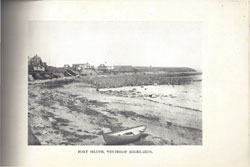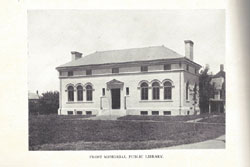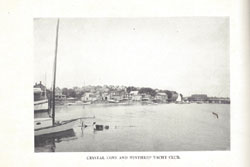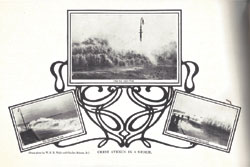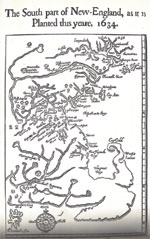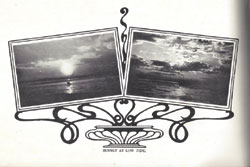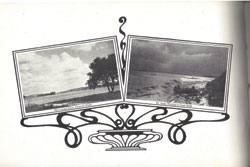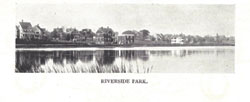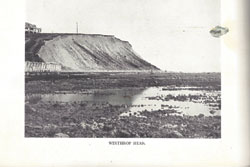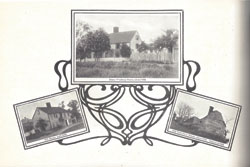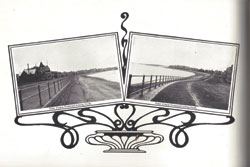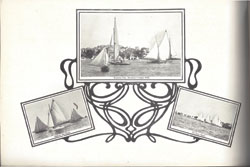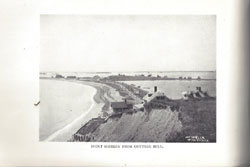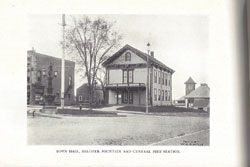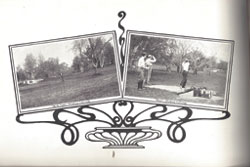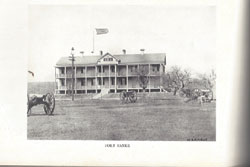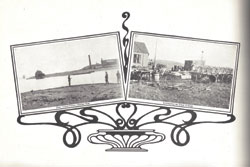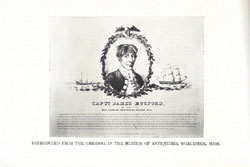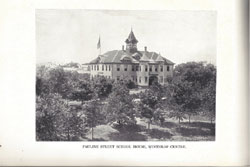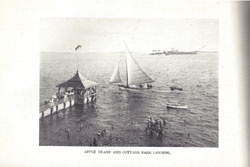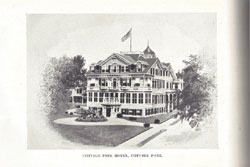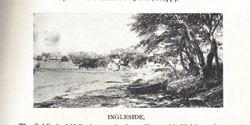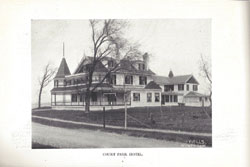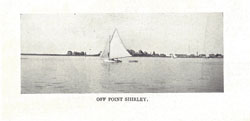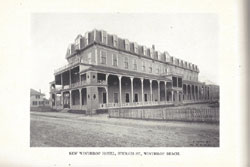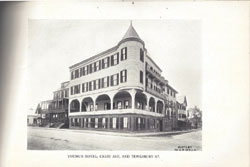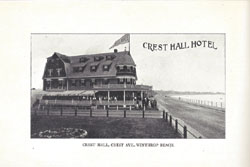3
4 Chapter I Historical and Introductory Winthrop, set-off from North Chelsea, March 27, 1852, completed its fiftieth year of independent municipal existence A. D. 1902. The day was formally celebrated with interesting literary and musical exercises, an exhibition of old and valuable relics, papers and documents, and rare beautiful paintings, photos, reprints, etc. pertaining. to the town, or its residents, past and present. Only a very few inhabitants could attend these exercises, and the season forbade an out-of-door celebration on March twenty-seventh. It was voted at the annual town meeting to appropriate $2,000 to defray the expenses of a suitable public celebration. and a committee of 'twelve gentlemen, were appointed to carry out the purpose of the town. It has been thought fitting that some brief historical sketch suitably illustrated, should be prepared for this occasion. The illustrations are almost wholly Winthrop views, and reflect great credit on the skill, taste and enterprise of the photographers. The facts stated are from the best authorities. So small a history can do little more than to depict what Winthrop has been and is : what notable events have occurred within her territory : and what manner of men have for a time made it the theatre of actual and noble lives. Named after Governor John Winthrop, the founder and first ruler of the Massachusetts Bay Colony, and for some fifty years the home of his son Deane: Winthrop has reason to be proud of her name, which moreover is one of varied, yet always creditable significance. "Winthorpe" is an old English town name, "thorpe" meaning a town or village. "Win" means beautiful: also possessing the charm of attraction (winning) : and lastly as a prefix sometimes signified that a battle had been fought and won near by. On the other hand men of Danish or Norse, England would derive it from "Vin" vine or wine (" thorpe," village) i.e. a village of vineyards· or wine-making. In each sense of the word Winthrop is well named. It is a beautiful town: a town, whose charm has been confessed by myriads of residents and transient visitors; vineyard and orchard have again and again borne off the first prizes in public competition, and its territory during the revolution was twice the theatre of a British defeat. It has always been a beautiful land since Leif, the Fortunate, the adventurous son of Erik Raudi (The Red) steered his Norse galley past the Nahant Ledges, and saw before him the sheltering island which shut off the seas from the northern entrance a thousand years ago. Now the OuterGraves, the Brewsters and the great shoals, are but the broken skeleton of a fair island cape, which battering breaker and swirling tide and undertow, have laid waste and dispersed in dangerous reef and shoal. Then forests clothed its slopes, and a strange race found there in part, a home and country. Such a haven and such a land were a perfect paradise to men from 5
6 bleak and winter-accursed Greenland, yet Leif tarried not but rounded Cape Cod, and found a peaceful and fruitful land in Vinland, the Good. So did Thorwald, the Ill-Fated, who died under the arrows of those "Skroellings" or " Mannikins," of whom the old Norse Sagas make mention. So too, did Thorfinne Karlsefne, of the three long ships, last of those of whom the Sagas speak certainly as living in and ruling Vinland. Doubtless they staid not on this 'coast, because no one of them, not even Karlsefne, with his three tall ships and six score stout archers and axemen, dared to settle and plant a land in which there were thousands of valiant savages. The Esquimaux, then ranged south as far as Massachusetts Bay, and were not only the possessors, but jealous defenders of this land against that Indian enemy, who was to drive them from it into Arctic desolation. Nothing is said in the early Sagas of any natives in Greenland, and the description of the people with whom Thorwald fought his last battle, was not of Indians but Esquimaux. Then walrus, seal and Arctic bird life lined the whole American coast north and east of Cape Cod, and one of the first holders of Winthrop territory, Edward Bates, went on an expedition to Sable Island in 1638-39 to hunt walrus there. In 1606, the Abenaquis of Nova Scotia were still hunting down the Esquimaux of Labrador and Gaspe, against whom Membertou, their great warchief, led a mighty expedition in war canoes from Annapolis Royal. The Norsemen, who were visited in Vinland by a bishop of Greenland in the 14th century, must often have visited this bay in three centuries of voyaging, trading and discovery. They were destroyed by plague, famine or massacre about A. D. 1350, or, cut off from Norway by the general and utter stagnation which followed the terrible mortality of the Black Death in northern Europe, gradually sank into savagery, as hundreds of white families have done in our own day. Those old Norsemen, over twelve hundred years ago, had "Snekrs" or galleys, of fifty, sixty and even one hundred feet in length, in which their greater "vikings" sailed from the Baltic Sea to the Black, and visited, as guest or pirate, the ·Mediterranean shores of Europe, Asia and Africa. There are strange stories of "sea thief" and honest trader blown far to the westward by weeks of tempest, making shelter in unknown lands and havens, and finding among a strange and valiant people, princes who spoke the Norse tongue; knew the great chiefs of Iceland and Norroway, and sent the refreshed mariners away with gifts of remembrance, and warnings that no white settlement might hope to endure among that fierce and valiant people ; who, according to Antonio Zeno, a Venetian mariner of the 14th century, were described to him by a Biscayan fisherman as "descended from the Scandinavians of the Vinland colonies." This was a fair land when John and Sebastian Cabot in 1447, Gaspar Cortereal, a Portuguese, and Verrazano, the Florentine, in 1524, Esteban Gomez, a Spaniard, in 1525 and Bartholomew Gosnold, in 1603, voyaged along these shores and rudely charted the rugged New England and Canadian coast line. Besides these recognized discoverers, a host of unknown fishermen and traders fished the Grand Banks of Newfoundland, and thence sought the islands for water, bait and fuel. As early as 1501-1504, many Norman, Breton and Biscayan fisherman had begun the Grand Banks fishery, and were soon followed by their English and Dutch rivals, until hundreds of ships gathered their lading on these banks and along the nearer coasts of North America. From fishing, to trading for furs, Indian trinkets, walrus and narwhal ivory and the like was an easy transition, and often a very profitable one. These unrecorded and obscure skimmers of the seas, impelled by the desire of gain, the determination to make a meagre season successful, or a natural restlessness of spirit and desire of adventure, undoubtedly did more to discover and develop the resources of America, than all the noted discoverers and their kingly patrons together. In 1622, Captain Richard Whitbourne estimated that the English fleet alone, then fishing on the Grand Banks, and resorting to the Newfoundland harbors at need, aggregated 252 ships of 15,000 tons and manned by 5,000 men and boys. At that time the only permanent settlement on the New England coast was at New Plymouth. When the tiny shallop of Des. Monts, of only seventeen tons, with twelve mariners and two Indian pilots, anchored off Noddle's Island in 1605, they found the Bay of Massachusetts, or as they styled it, Port St. Louis, 7
8 the center of a great Indian population of 150,000 to 200,000 souls. Thirty thousand fighting men defied aggression and carried fire and massacre into lands hundreds of miles away. Indian villages of bark or mat lodges and cabins, some of them large enough to shelter forty men, and defended by palisades of poles, thirty or forty feet long, set close together, surrounded by deep ditches and bridged by a single broad plank or log, amid fields of maize or Indian corn, beans, pumpkins, squashes, melons and tobacco, were to be seen on every hand and on most of the islands of the harbor, and great fleets of canoes, gathered to greet and examine the visitors. All the way southward, even on sandy Cape Cod, the same evidences of large and prosperous Indian communities were observed. So Des Monts settled Acadia, because he dared not attempt to risk a European colony in the Bay of Massachusetts. The valiant Capt. John Smith, in 1614-15, said of this harbor and its people, "The country of the Massachusetts is the paradise of these parts. The sea coast as you pass shows you all along large corn fields and great troops of well-proportioned people. We found the people in those parts very kind but in their fury no less valiant." A year or two later a French trading vessel anchored off Lovell's Island, are surprised by a war party, and all the crew perished, except three or four who were enslaved by the Indians and sent from one village to another, as we exhibit wild and rare animals. Probably this was done to avenge the treachery of Capt. Hunt, who, in 1614, visited this coast and kidnapped some twenty Indians, whom he carried to Spain and sold into remediless. Among these prisoners, one carried a small book, in which he read much, and in his last days tried to teach the Indians of God, and of his wrath against the wicked and merciless. He warned them, as the Indians themselves confessed, that God's judgment would fall upon them for their pride and cruelty. Shortly after this man's death a great pestilence devoured the people of the Bay, as a fire sweeps through a withered forest. The tribes were almost annihilated, and their tribal enemies, the Tarratines of Maine, laid waste their villages and fields, and slew and made captive, until scarcely three hundred fighting men remained alive. These sought the protection of friendly tribes, or hiding places in the wilderness, and when the first settlers came were in no condition to oppose them. In the day of their strength, Nanepashemet had ruled the Massachusetts, but survived the ravages of the plague to leave his dead by thousands to the wolves and ravens in their rotting cabins and deserted fields. Later, gathering a small force, he erected a little fort at Mystic Hill, defending it with tall, thickly set poles and a ditch breast deep; but the Tarratines slew him and his handful of warriors in 1619, a year before the settlement of New Plymouth. His widow became the Squaw Sachem of Naumkeag or Salem, and his three sons laid their father's remains in a new fort, like that in which he had been slain, and thereafter lay accursed and desolate forever. In due time Nonohaquaham, or Sagamore John as the Puritans called him, ruled at Mystic, Montowampate (Sagamore James) at Saugus (Lynn), Naumkeag (Salem) and Wabequash (Marblehead), while Winnepoykin, the youngest, lived with his mother and brother, in due state and ancientry. They did not return to their old centre of government at Massachusetts; it was to them a land of ghosts, of awful tragedies, and utter desolation, and doubtless of greater dangers from prowling Abenaquis, and the white traders of the coast. Poquanam of Nahant, and Chickataubut of Neponset, seem alone to have held a part of this deserted territory when Winthrop's little squadron sailed hither with the founders of Boston. It was on the 6th of April 1630, that his ships lay "bound" for New England at Cowes in the Isle of Wight, where 222 years later the America was to humble the pride and boast of Britain's most skillful shipwrights and mariners. All his vessels were ships; the ArbelIa, formerly the Eagle, was the largest of 350 tons, 28 guns and 58 men under Captain Peter Milbourne, The Ambrose, Captain John Lowe.; the Jewel, Captain Nicholas Hurleston; and the Talbot, Capt. Thomas Beecher or Belcher, are all armed with small cannon and large swivels and blunderbusses, with which a murderous hail of round pebbles and "musket and pistol shot" can be discharged upon an enemy. They carry also great muskets with matchlocks, pikes, javelins, long and crossbows, daggers and pole-axes for the crew, beside the private 9
10 armor and arms of the passengers. The colony also provided a stock of arms and munitions of war: heavy culverins and sakers, for forts and garrisons: lighter artillery for blockhouses and small armed vessels; muskets, fowling pieces, swords, pikes, halberds and drums; suits of plain black and bright steel half armor, and full equipments and supplies of ammunition for all arms. Their sea-stores seem strangely coarse and unsavory to the modern voyager. The Arbella had neither tea, coffee nor chocolate, but in place thereof substituted fourteen tons of water, forty-two tuns of beer and two hogsheads of cider. There is but one barrel of flour and 10,000 pounds of ship's bread, forty bushels of peas, thirty bushels of oatmeal, sixteen hogsheads of beef, three cwts. of cheese, and two cwts. of suet. Butter does not appear in the list, and only six dozen candles. It is probable however that each family provided stores of food for the voyage; and among them wine, spirits, figs, "raisins of the sun," sugar, "vitriol and lime juice against scurvy and such vegetables and delicacies as could be taken to sea in those days. They landed Saturday, June 12, 1630, at Salem, where John Endicott ruled over a half-score of houses and a handful of settlers of previous years. On Thursday, June 17, Winthrop and his associates "sailed to the Massachusetts to find a place for our sitting down," probably entering the harbor at Shirley Gut, then from four to five fathoms deep at low tide. Sailing up to Noddle's, or Nottle's Island, they were hospitably entertained by Samuel Maverick, whose strong log house, mounted with "four murtherers" (swivels) was the only house thereon. William Blaxton, or Blackstone at Shawmut, or Trimountain; Thomas Walford, the blacksmith of Mishawum, or Charlestown, William Thompson, on Thompson's Island, and Maverick, had by from one to five years preceded the Boston Colony. On their return they went out by Nantasket, where Capt. Squeb of the ship Mary and Rose, was trying to bulldoze certain west-of-England colonists into allowing him to land them on that narrow beach instead of on the main land. Having brought him to reason and an agreement to land the newcomers at Mattapan (Dorchester) their little craft bore away for Salem. Thence, in July, the Arbella, Talbot, Ambrose and Jewell brought the colony to the Charles River where they settled at various points, but chiefly at "Newtowne" and Charlestown. How they were wasted by disease, and suffered from fear of Indians, wolves, rattlesnakes and bad water, were too long to tell, but these four dangers and Blaxton's hospitable invitation to the peninsula and sweet cool springs of Shawmut, resulted in the founding of Boston. Here they built a frontier village chiefly of Indian cabins, bark wigwams, log huts and houses, thatched with the coarse grass of the submerged marshes, and even caves in the banks, enlarged by rude walls of boughs and clay. There they barred the neck with ramparts and guard houses, established rules for hygiene, and the administration of justice, and began in due time to plant the wilderness round about them. One of the earliest orders of the committee which arranged for the allotment of the public lands passed in 1632 "Ordered that the necke of lande betwixt Powderhorne Hill and Pullen Poynte, shall belong to Boston, to be enjoyed by ye inhabitants forever." This was probably done to insure a source of wood supply and a great common pasture ground easily fenced and guarded. Two years earlier an inquest held on the body of one William Bateman, elicited the fact that on a certain Saturday, he, with other fishermen, had their boats at Pullen Poynte ; that he, not feeling well, said that he would not sail for home with the others, who left him beside his boat with plenty of food and fuel. On their return on Monday, however, Bateman was found dead beside his boat, being the first white man known to have died within the limits of the town territory. Why Point Shirley was called "Pullen Poynte" and the southern shore of Winthrop "Pullen or Pulling Poynte Necke" is thus explained by William Wood, who visited Boston as early as 1634, and says in his "New England's Prospect": "The last towne in the still Bay is Winnisimet; a very sweet place for situation, and stands very commodiously, being fit to entertain more planters than are yet seated; it is within a mile of Charles Towne, the river only parting them. The chief ilands which keepe out the winde and the sea from disturbing the harbours are first Deare Iland, which lies within a flight shot of Pullin Point. This Ilaud is so called 11
12 because of the deare which often swimme thither from the maine, when they are chased by the woolves: Some have killed sixteene deare a day upon this i laud. The opposite shore is called Pullin Point, because that is the usual channell Boats used to passe thorow into the bay; and the tyde being very strong they are constrayned to goe ashore and hale their boats, by the sealing, or roades whereupon it was called Pullin Point." John Winthrop's map (1633) does not name the point and the name first appears in Wood's map of 1634. At various times the point has been called Pullin's, Pulleine's and Pudding Point, but Pulling Point has at least the warrant of the earliest printed explanation and some centuries of use. In 1632 it was further ordered "That noe pson w'soever shall shoote att fowle upon Pullin Poynte or Noddles Island, but the sd places shall be reserved for Jobe Perkins to take fowle with netts." The ancient and honorable mystery of a fowler, i.e., a man who captures wild birds alive, by means of nets, snares, bird-lime etc. was an important calling in the England of that day, and still supplies the English market with no inconsiderable part of its game. It cannot however be employed when the birds are liable to be startled by the explosion of a fowling-piece, and therefore the whole of Noddle's Island and "Pullen Poynte," were tabooed to the colonial sportsmen for a season. It was a noble territory for the exercise of Jobe Perkins' art, embracing nearly three thousand acres of marsh and creeks, and enclosing forest land, the chosen haunts of animals and birds innumerable. For in that day the outer rocks, islets and sandy wastes were the nurseries of countless wild-fowl, and a multitude of species: among these the Great Auk (Alea Impennis), now deemed extinct, nested with gannet, shag, comorant, puffin and gulls and terns of many species; harp, hood and harbor seals of all kinds basked on the rocks and ledges, and now and then a walrus or two strayed from the southern herd at Sable Island, bared great grim tusks among the gentler phocae of these waters. The broad winged, graceful wild swan haunted harbor and river, and great sand hill cranes stalked over the sand-dunes and open barrens, or preyed upon the cornfields, to be shot down from ambush, and salted down to be eaten with turnips. Wild geese then bred in Massachusetts, but their migrating hosts in the spring and fall, blackened the floating ice, still waters, and brown marshes with basking and feeding myriads, whose clamorous calling and roar and rush of flapping pinions when disturbed could be heard miles away. "I have often had 1,000 at the end of my gun," writes Morton in 1642, when for twelve years the English muskets had to a great extent broken up the once peaceful haunts of these wary birds. Brent geese, mallards, canvass backs, pochards, eiders, black ducks, teals, widgeons, coots, sheldrakes, and many other species of water-fowl, largely bred in the marshes and swamps along the coast or in their migrations, filled the sky-line along the coast with endless processions of swift winged hosts. and blackened the seas below with feeding myriads. In the woods fed the lordly moose and many deer, with rabbits, squirrels, raccoons, partridges, woodcock and quail. Wild turkeys were wonderfully abundant being found says Wood "forty, three score and even a hundred in a flock." "There have been seen a thousand in one day," writes Morton, who was the keenest sportsman, and probably visited more remote forests abounding in nuts and other food. This splendid and delicious bird was however so rapidly extirpated in eastern Massachusetts that Josselyn in 1672 writes, "The English and Indians having so destroyed the breed that it is very rare to meet a turkey in the woods." Of wild pigeons, says the old chronicler, there were "millions and millions," insomuch that their migrating flocks shadowed the earth for leagues, and at their great breeding places, large branches went crashing down in the still night, so closely did the birds nestle together upon them. Plover were little thought of by most, who would not "waste their shott on suche small fowle." " Sanderlings," says Morton "are easier to come by; because I must but a step or two for them. I have killed between four and five dozen at a shoote, which woulde loade me downe." A larger species, still known as " humility" plover among the bay gunners, were so strangely plentiful and tame that Wood says of these" humilities and simplicities " then so called; "Such is the simplicitie of these smaller birds that one may drive them on a heape, like so maniesheep, and seeing a fitte time, 13
14 shoote them. The living seeing the dead, settle themselves in the same place againe. I myself, have killed twelve score (240) att two shotts." For all of these varied species of game Jobe Perkins had his nets, springes, toles and other devices, such as one may find today only in some "Complete Sportsman" or other ancient manual of hunting and fowling of the old days. But doubtless his chief reliance was the duck net, still used in the fens and meres of Lincolnshire. Probably the "Crooked Lane" as "Belle Isle Inlet" was then called, or one of its smaller arms was prepared for the work. Arches of light hard wood saplings were erected across the stream and a very fine, large-meshed netting closely stretched over them, forming a funnel, wide at the mouth and growing smaller by degrees as it followed the windings of the creek, until it became a mere purse in which a duck could barely stand upright. At the entrance a blind of growing bushes or reeds concealed the master fowler, who sent out a trained spaniel whose antics often decoyed the curious fowl that swam after him as he retreated deeper into the net. Then the fowler appeared behind them, and the frightened birds swam deeper and deeper into the toils, until they could be taken and killed one by one. A thousand ducks and more, have thus been taken out of one English mere in a single day and night, and not less deadly devices were used against every other sort of fowl, from meadow larks to wild pigeons. Nevertheless it does not appear that "Jobe Perkins" made a great success of his fowling. Perhaps he accepted the judgement of the old rhyme now almost forgotten. "A fyshermanne is seldome riche, A fowler-manne is never. Ande he who lives by shootinge bucke Will live ande dye a beggar." At any rate he removed to Ipswich in 1633, and represented that town in the general court in 1636.
Riverside Park 15
16 Chapter II Allotment and Settlement Picture Cottage Park In September, 1635, Winnisimmett was annexed to the town of Boston, and on the twentyfifth of the same month Wollaston and Rumney Marsh. The latter name was one dear to the earlier colonists, as that of a fen near Chelsea, England, and included the present localities of Revere, Orient Heights, Beachmont and Winthrop, with all the marshes, creeks and beaches thereunto appertaining and the islets of Apple, Snake and Deare Island. Then and thus, Winthrop territory became a part of Boston, and the allotment of lands in severalty to the more prominent citizens, showed how the ripened judgement of four or five years, chose out in this section the most desirable lands; perhaps the more readily, that the Indian title to them had been somewhat unexpectedly extinguished. As early as March 26, 1631, John and James, the sagamores of Winnisimmett and Saugus, came from their winter camp at Mystic, where their dead father still lay in his fortress tomb, followed by ten warriors, on a visit of ceremony to the governor. Winthrop had received a like visit from Chickataubut of Neponset on the twenty-third, and in April, Wahgannacut, of the Narragansetts, came with Sagamore John, having as an interpreter, Jack Straw, an Indian who had lived in England, under Sir Walter Raleigh, and after his death had returned to America and a savage life. Sagamore John appears to have been well-disposed to the whites, for in July he came in again, this time with a son of Canonicus, the great war chief of the Narragansetts, who brought as a gift a great beaver skin, and received in return a bright and capacious ale tankard. All seemed peaceful, even among the tribes themselves. But on the night of August eighth, five-score Tarratines from western Maine came up the coast in three great war canoes, ascending the Merrimac to Agawam (Ipswich) whose Sachem Metamomet was enjoying a visit from Sagamore John, his brother James, and many of their relatives. The Tarratines slew seven men outright, wounded many more, among them Sagamores John and James, and carried the latter's wife a prisoner to Pemaquid, where she was ransomed through the English. On Sept. 4, 1632, Sagamore James of Saugus, bought a musket, pistol and ammunition of one Richard Hopkins, but the bargain was declared off by the Puritans. Hopkins was publicly whipped and branded on the cheek. In November, 1633, Chickataubut of Neponset, died of the small pox, with most of the men and women of his tribe, and in December, Sagamore John ofWinnisimett took the contagion. Mr. Elias Maverick, of Winnsimett with his wife and servants fearlessly cared for the Indian chief, but Nonohaquaham died with thirty of his people, and Montowampate of Saugus (Sagamore James) soon succumed to the pestilence. Winnepoykin (Sagamore George) succeeded at the death of his brothers to all the territory north and east of the Charles to the Merrimack. He married Ah-ha-wayet, a daughter of Poquanam of Nahant, and lived until 1684. Doubtless his brothers, Nonohaquaham and Montowampate, before him sold to the land grabbers of their day, the greater part of that realm over which Nanepashemet, "the great Babasha" had held sway. Probably Winnepoykin himself, had no choice but to glean what he could of duffle coats, axes, knives, kettles and the like in exchange for the remnants of his tribal patrimony. At any rate in 1685, his heirs were induced to sign a deed, releasing their interest in the lands "at or near Winnesimet, Rumney Marsh and Pullen Point to such as are 17
18 entitled to the same by long possession and legal descent from such persons as originally purchased from ye Indian Sagamores." Previously, the Clerk of the Court of Assistants made entry in "The Book of Possessions," "I634, Winthrop Deane, Pullen Point, about I 20 acres: Mr. Pierce, N., Bay and Fisher's Cove, W.: Pullen Pt. S: Sea, East. October 26, 1649, Bridget and William Pierce, grant Mr. Deane Winthrop their farm at Pullen Point, about 100 acres." It will appear hereafter that this grant to Deane Winthrop, was made before he arrived at man's estate, or indeed had come into the country, and explains why Governor John Winthrop, besides large holdings elsewhere received two grants at Pullen Point. It is desirable to remember that the following dates are "Old Style," that is according to the Julian Calendar, which beginning the year with March 1, made September, October, November and December, the seventh, eighth, ninth and tenth months in fact as well as in name, January being the eleventh and February the twelfth month of a year notated 34-35 or the like. On February 23, 1634-35, it was ordered; "It is agreed by special consent that all barren cattell whatsoever, (except such as are constantly employed in draught) weaned caulves twenty weeks old, and weaned mayle kidds, shall be kept abroard from off the necke, and for everyone unput away within a week after warning 2S and 6d (shall be paid) for every week not put away; and our brethren, John Sampford, William Cheesebrough and William Boston to take care for the observing of this order." "Item.That there shall be a little house built and a sufficiently payled yard to lodge the cattell in of Nights at Pullin Poynt Necke before the 14th day of the nexte second month (April 14, 1635) On the 13th of April it was furthered ordered, "Item: That all the drye cattell that are put unto our brother William Chesebrough for keeping at Pullen Poynte Necke, untill the first of the ninth month (Nov. 1) shall be at the rate of 5s. a head unto him." The house and palisadoed yard thus erected were certainly the first built by Massachusetts settlers, within Winthrop territory. William Chesebrough, constable of Boston, and cattle guard at Pullen Point Neck, must have had his "corral" and house somewhere between the Court Park section and the Town Hall, as the natural water supply for the cattle, was the swamp that formerly stood near the site of the Winthrop Centre Station. We must therefore picture to ourselves an opening in the wooded promontory of what is now Court Park, in which a stout little log house, loop holed for musketry, having a strongly-barred door and shuttered windows, stands beside the gate of a large enclosure of long saplings deeply set in the earth, and pinned or wattled together. Cheesebrough stands by the gate, clad in doublet and hose; stout stockings and heavy shoes, armed with a long-barrelled fowling-piece and attended by a brace of hounds, trained to hunt the gaunt grey wolf, savage wild-cat and black bear. A fence across Short Beach stops the cattle from straying further up-country, but his vigilance can never be abated, for rovers of the sea, or the Indian enemy may at any time raid his lonely realm. The sun is near to setting, and within the palisades, a score of newly-arrived cattle, just landed from a great scow, are uneasily inspecting their novel surroundings, He calls the lagging cattle as they come slowly up from the hollow land, stopping to drink as they skirt the flooded swamps, fragrant with "blue-berry browse" sweet briar and wild azaleas, and vocal with the love notes and noisy chatter of many birds. They come slowly up to the open bars: first the great bull, majestic and red-eyed, then a smooth-coated cow fattening for the butcher; here a bevy of frisky calves, and then a flock of sheep and goats herding together for mutual protection. For as all men know, from Mystic ponds, through Saugus woods and adown the Rumney Marsh lands and beaches, the grey wolves hunt the buck, until he dies amid the pack, or leaping into Pullen Point Gut, reaches the thickets of Deere Island and safety. The wolves like mutton as well as venison, as yonder grisly heads and shaggy pelts, pinned to the logs bear witness, and even as Cheesebrough puts up the bars, the shadows deepen and afar off a fierce, yet melancholy howl, tells that the old dog-wolf is calling in the pack. The housekeeping is of the plainest. A hanging-table, a rude berth bed, a joint stool and a fireplace built up of logs and clay, are all the furnishings. A wooden trencher, whose bowl-like cavity is turned out of a square foot of solid oak plank is his only plate. Forks are unknown, and a pewter 19
20 spoon, the dagger at his belt, and a porringer and tankard make up his table equipage. His shelves hold huge loaves of wheaten bread from Boston, dark hued and thickly crusted, with a little store of peas, oatmeal and "nokae" (Indian corn parched and beaten) a famous food for long marches and beleaguered garrisons. His drink is "fayre water" from the spings along the shore, or cider and small beer sent him in stout runlets. A thick black glass bottle of brandy, or Schnapps, lurks somewhere in the thatch or in yonder locker, kept for moderate use, on special occasions. Game is so plentiful that he rarely lacks meat; great lobsters lie at low tide in the little pools on the flats, and clams and quahaugs are to be had for the gathering. Eels, flounders, sea-bass, mackerel, smelts and tom-cod are over-plentiful and easily taken, and his long-barrelled gun seldom kills less at a "shoote" than suffices himself and his dogs for a day at least. He "drinks" or as we say smokes black Trinidado, or light brown Virginia tobacco in a short, thick-stemmed clay pipe, and finds therein so great solace and content, that he worries himself with fears of undue and sinful indulgence therein. He reads much in yonder stout leather-bound bible, and chiefly of the Exodus of the Jews, their forty years wandering in the wilderness, and conquest of the heathen about them; and sees therein a symbol of the dangers and mission of the Boston colony. Steel cap and breast plate, back-piece and tasletts, black lacquered and palinly finished, hang against the wall, with a cut and thrust sword, a great horn of powder and a leathern hunting bag, heavy with bullets and small shot, flints, wadding, and like munitions. He has a tall pole on yonder point, and an empty tar barrel near at hand, whence either flag or flare will soon be noticed by the town watch, should he stand in need of their prompt re-enforcements. He is not always alone, for an Irish servant, saved from rope or massacre in ill-fated Erin, and sold like a serf, to five years servitude, is coming across from the town with messages and supplies of provisions. This man undoubtedly was the first summer resident of Winthrop territory, but he was not long a citizen of the Massachusetts colony. In 1638 he removed to Braintree. Later he settled at Rehoboth and in 1849 went to the Pequot country, becoming the first settler of Stoughton, Conn. On January 9, 1636-37, the following grants were made: John Ollyvar, "fifty acres at Pullen Poynte" ; Mr. Wm. Brenton, "twenty acres at Pullen Poynte Necke" ; Mr. Edward Gibbon, "four score acres at Pullen Poynte, it it is there to be had." On June 12, 1637 there were laid out for Mr. Willyam Pierce, one hundred acres of upland and marsh land, at Pullen Poynte Neck; Mr. Edw. Gibbon, eighty acres upland and marsh; John Ollyvar, fifty acres upland and marsh; Mr. William Brenton three score and four acres of upland and marsh, and one hundred acres ., on the other side of Mr. Aspinwall's," (at Rumney Marsh, Chelsea). Also Edward Bayts hath fourteen acres laid him out there (at Pullen Point Neck.) On November 13, 1637, "also there is granted to the Governor, Mr. John Winthrop, the two Hills next Pullen Poynte with some barren marsh adjourning thereto; provided that it be no hindrance to the towne's setting up a ware (weir) in Fisher's Creek or fishing basse there." These allotments were ratified Jan. 8, 1637-38 as follows: At Pullen Poynte Necke; William Stidson, 30 acres; Edward Bayts, I4 acres; Ralph Hudson, 12 acres; Thos. Matson, 28 acres; Mr. Edward Gibbons, 110 acres. "At Rumley Marsh and (near) Pullen Poynte," Richard Tuttell, 161 acres; John Glover, 49 acres; William Dyar, 42 acres; Samuel Cole, 105 acres; William Brenton, 164 acres; William Aspinwall, 164 acres. "At Pullen Poynte Necke" Mr. William Aspinwall, 22 acres; John Sanford, 6 acres; Thos. Buttolph, I4 acres; Mr. John Winthrop Sr. Governor 50 acres; John Ollyvar, 50 acres; Wm, Brenton, 64 acres; Elias Maverick, 12 acres; Thomas Fayreweather, 34 acres; William Pierce, 100 acres; and the remainder from the latter's line to Pulling Poynte Gut, to Governor John Winthrop; say I20 acres. On Sept. 29, 1645, the informality of these grants was thus cured, "Whereas the several grants of house lots and other lands recorded in the town book, are entered only as granted to the parties themselves without mention of their heirs, it hath been thought fit to be declared and ordered, that all grants were and shall be intended to be estates in fee simple with all due and usual privileges. Each grantee was obliged to build some kind of a house on each portion 21
22 of land allotted him, within a certain fixed period. Edward Bayts, or Bates, who received an allotment of fourteen acres at Pullen Poynt, Jan. 1637-38, sailed that winter to Sable Island to kill walrus, black foxes and red cattle, and did not get back in time, on March 30, 1640, was "allowed six months to build upon his lot." It is likely therefore, that in 1640 every allotment here had some kind of a dwelling upon it, although most of them might be little more than a small log house, or even an Indian cabin, as small and evanescent as the "claim shanties" of the earlier western settlers of Dakota and Iowa. John Winthrop, the first governor, built on the southern face of Great Head, somewhere near the junction of Shirley Street and Shirley avenue, and undoubtedly spent some part of his time there as he did at his island retreat at "The Governor's Garden" and his Ten HilIs Farm at Rumney Marsh, where in 1631 he built the little thirty ton bark "The Blessing of the Bay," launching her on the 4th day of July. In 1633, he received from a friend four Irish grey hounds, trained to kill wolves. Of these he was evidently proud as he says in his diary, in 1634 "The dogs killed an old wolf this morning in our neck. She made more resistance than both the former (ones)." William Aspinwall we know had one, because Governor Winthrop's diary, says Jan. 13, 1637-38, "About thirty persons of Boston going out in a fair day to Spectacle Island to cut wood. The next night N.E. wind with snow, (then wind) at N.W. two days. It froze so hard as to leave only a narrow channel by which twelve got to the Governor's Garden. Seven men were carried in a small skiff out of Broad Sound to the Brewster's, (whence after being) without food or fire two days, they got to Pullen Poynte and to a little house of Mr. Wm. Aspinwall's. Three got home on the ice (with) hands and feet frozen. Some lost fingers and toes and one died." Mr. William Aspinwall's allotment skirted the harbor front, somewhere about Cottage Park and Johnson Avenue. He was one of the first members and Deacons of the First Church of Boston, but sided with Mrs. Hutchinson and Dr. Wheelwright, and went to settle in Aquiday (Newport. R.I.) in 1638. Later he returned to the Massachusetts. He was a Fifth Monarchy man, and expected to witness the battle of Amageddon and the establishment of Christ's Kingdom on earth. Mr. Edward Gibbons, had a very comfortable farmhouse, somewhere near the great elm at Thornton Park Station. There were several rooms, a part of which were fitted up for the use of his family, although he had a house of more than usual pretension in Boston. In his day the flats between Snake Island and the surrounding shores were a clean sandy gravel, and at low tides an ox team or a man on foot could cross to Snake Island or Great Head. His land extended from the junction of Pleasant and Winthrop streets to the creek and harbor on all sides, and the fishing rights to take bass, herring, mackerel and the like were undoubtedly of great value. He lived here in the winter of 1641-42 when, as Winthrop records, "The frost. was so great and continual this winter, that all the bay was frozen over; so much and so long, as the like, by the Indians relation, had not been these 40 years, and continued from the 18th of the present month (January) to the 21st of 12th month (February); so as horses and carts went over in many places where ships have sailed. Captain Gibbons and his wife, with divers on foot by them, came riding from the farm at Pullin Point right over to Boston, the 17th of the 12th month, when it had thawed so much as the water was above the ice half a foot in some places." He was a captain in one of the two regiments, which in the summer of 1639, "mustered at Boston to the number of 1000 soldiers, able men and well-armed and exercised. They were led, the one by the governor, who was general of all, and the other by the deputy who was colonel, etc. The captains showed themselves very skilful and ready in divers sorts of skirmishes, etc., in which they passed the day. About two-thirds of these men were musketeers, carrying a large bored match lock with a rest to set into the ground and support the piece when Firing. The lighted match carried between the fingers of the left hand, was of twisted tow impregnated with nitre, and burned slowly with a hard and compact coal. This was placed in the gripe of the cock or hammer, and brought down on the priming of the uncovered pan by a steady pressure of the trigger. Musketeers seldom wore armor of steel, but many had buffcoats 23
24 of thick leather and quilted doublets which would resist an Indian arrow. A belt of bandaliers across the left shoulder held suspended twelve little leather cases, eleven of which held charges of powder, ball and wadding, and the other fine powder for priming the piece. There were no bayonets and each man wore a sword. One-third were pikemen in halt armor, i.e. plain bascinets, breast and back pieces, and tasletts or protectors for the thighs. A pike from fifteen to eighteen feet long and a cut-and-thrust sword with sometimes a dagger or pistol made up the armament of men who had to endure the fire of artillery, musketeers and horsemen, until a charge brought them to "push of pike." As horses became plentiful, bodies of dragoons and mounted infantry were organized. The horsemen's pistols of that day were very long and heavy, and used to break the ranks of pikemen before making a charge. Every man, with very few exceptions, was bound to arm himself as a pikeman, musketeer, or horse soldier, with sufficient ammunition for an immediate campaign; even if too old or infirm to use them, he must still have ready the arms and ammunition, and supply all his children, servants and apprentices of military age. Gibbons had an especial liking for military service, and at the time of his death in 1654, was Major-General of the Colony Troops. The inventory of his estate December IS, 1654, shows in his house a leading staff, French gun, Spanish sword and dagger, and powder-horn. In the" Artillery Rooms below," there were seven muskets (matchlocks), six harquebuses (probably flintlocks) seven pistols, one crossbow and one longbow with arrows, a dart or javelin, a pole axe, five glass grenadoes (to be lighted and flung by the hand among the enemy) one Indian bow a Brazil Chief's, two suits of mail, one complete corslet and pike, sixteen pieces old armor, four brass guns, one iron gun and their carriages, a little Biscayan shallop. At the Pullen Point Farm he then had the following stock: two white-faced oxen, four four-year old red steers, two three year old steers, one bull and two yearlings, one two-year old heifer, one three-year old heifer; five cows, one mare and colt, one cow and calf, one boar, six sows and hogs, seven small hogs, ten pigs, two fat hogs, one ram, two old and five young ewes, seven cocks and hens. In June 1643, Estienne de la Tour: who had in 1633 taken a trading outfit, which Allerton, of Plymouth, had established at Machais, Me., killing two men and carrying off goods and prisoners; came into Boston Harbor in the great ship Clement, from LaRochelle, France. the great Huguenot city of that era. She must have come in through Shirley Gut, for on the way up she met Mrs. Gibbons with her children and servants who were going to their farm. A French gentlemen knew Mrs. Gibbons and told LaTour, who launched a shallop to speak with her. She was afraid and took refuge at the Governor's Garden (Governor's Island), where Governor Winthrop with two sons and his son's wife made La Tour welcome. He came no longer as the arrogant French Seigneur, who claimed "all the Atlantic coast from Acadia to Cape Cod by the charter of the sword," but came complaining that the Sieur D'Aulnay blockaded his port of St. John with two ships and a galliot, so that in no wise could he get in to relieve his garrison. Governor Winthrop knew he was at the mercy of La Tour, for the little fort was dismantled, and nothing could save two ships and a lot of cannon lying unmounted along the harbor. He sent Gibbon's servants to Boston with the news, and at supper talked over the position with La Tour, who was at least of the Protestant faith. After supper, Winthrop sent Mrs. Gibbons home in his own boat, and set out in La Tour's for Boston, being met on the way by three large boats filled with the Governor's Guard. Followed some days of discussion and formal courtesy, during which LaTour exercised on the common forty musketeers, and Winthrop a trained band of ISO musketeers and pikemen. The colony would not directly aid LaTour, who was however allowed to bargain with Captains Edward Gibbons and Thomas Hawkins masters and past owners of the ship Seabridge, fourteen guns, Philip and Mary, ten guns each, and the Greyhound of four murderers or big swivels, all fitted for sea or battle at £200 Sterling per month and to hire seventy musketeers for land service. One Chaddock, from the Bahamas, went on the same quest, which indeed drove off D'Aulnay and landed La Tour in St. John, but was a heavy loss to Gibbons as some say of £2,500. Chaddock who returned in a pinnace, taken fr0111 D'Aulnay, fitted her 25
26 cut for the West Indies, but she was blown up with all on board. One of the men had shocked the Puritans by his claims to magical power and his blasphemies and indecencies, and his death was considered a judgement upon him. Strange lights were seen oft Noddles Island, and men said that awful voices cried through the darkness "Come away! Come! Come, come away!" and the like. On August 26, Winthrop, whose diary abounds in such matters, records, " About nine in the evening there fell a great flame of fire, down into the water off Pulling Poynte. It lighted the sea far out. It was no lightning for the sky was very clear." The lonely shadows and solemn moonlights of that day, when light canoes and shallops found their way from lite little town to this sparsely settled wilderness, with the religious fervor or fanaticism, which involved their whole lives, predisposed the Bay colonists to a belief in the devil as an ever present persecutor of all Christian people. Some remnant of similar traditions lingered late among us. I remember well that one virtuous and Christian housewife, who for a time lived in the Deane Winthrop house, years before a railroad was built: told of a row of lights "like a train of cars" which came down across the marsh from the Centre and seemed to stop as at a station, before vanishing away. Similar lights have told of by other residents of the town, a phenomenon which has been recorded of almost every village along the Atlantic coast. In 1644 the war between King Charles I, and the parliament was at its height, and the most of the colonists were against the king. Capt. Stagg, of a London ship, laden with fish for Balboa, and carrying twenty-four guns, sailed at flood tide between a helpless Bristol ship and Charlestown and gave its captain one-half an hour in which to surrender. Having a commission from the Parliament, Capt. Stagg was allowed to depart with his prize, hilt a similar attempt resulted in the commission or Major Edw. Gibbons of Boston, and John Sedgwick of Charlestown, "to keep the peace in each town and allow no ships to fight in the harbor without authority." The same year LaTour's fort at St. Jean, besieged by D'Aulnay in his absence, fell by escalade after an heroic defence. D'Aulnay lost twelve men and many wounded and put every man, Frenchman or Englishman, to the sword. Lady LaTour died after three weeks of captivity, and her nurse and infant child were sent to France. La Tour lost in jewels and plate alone, the equivalent of $250,000, and Gibbon's claim of $12,500 became worthless. That same year Gibbons had to furnish a guard of honor to the embassadors of D'Aulnay, who came to demand redress for the warlike aid furnished La Tour. This was settled at little expense, and Gibbons turned his attention to voyages and land operations dying as already stated in 1654. His neighbor, Wentworth Daye, who had acquired twenty-five acres just west of Thornton Station, returned into England during the Civil War, fought under Cromwell, and became one of those Fifth Monarchy Men, "who looked for the present establishment of God's Kingdom on earth, preceded by the battle of Armageddon, and sore trials for the people of God on earth." Edward Bayts, or Bates, was brought over as a servant of John Leverett, but became a freeman and an enterprising seaman. He was disarmed in 1637 for signing the famous remonstrance against the persecution of Mrs. Hutchinson and Dr. Wheelwright. William Brenton came over in 1633, but removed with other remonstrants to Aquiday, (Newport), R.I., where he was an assistant in 1638-40 and 1642-45. Deane Winthrop, born at Groton, England, March 16, 1623, was named after his mother's half-brother, Sir John Deane, and left at school in England until 1635. From that time until his death in 1704 he claimed his residence in Boston, but in 1637 was with his brother John at Ipswich, Mass., and in 1646 at London, Conn. He also aided in founding Lancaster and Groton, Mass. He owned a large tract of land near the latter place, but in 1647 succeeded to his father's land at Pullen Point, which it would seem had been carefully reserved for him since 1634. He occupied at first a small house built by his father on the south side of Cottage Hill, near the corner of Shirley street and Shirley avenue, the present site of the residence of Wm. Austin, Esq. A row of willows has grown here from generation to generation, and a small depression like an ancient cellar existed here in the early part of the last century. Hence he could see Boston and set up a pole upon which he hoisted a bush when a ship approached the harbor. He married Sarah, daughter of the Rev. Jose (Ho-say) Glover, and later 28
29 step-daughter of Rev. Henry Dunster, president of Harvard College. His brother, Adam Winthrop, married Elizabeth, a sister of Mrs. Winthrop who died about 1683-84. By this first marriage he had nine children. He married a second wife, Martha, widow of Captain John Mellowes, who survived him, dying in 1716. In 1649 he bought of William and Bridget Pierce the farm upon which he builded the present" Deane Winthrop house," but just when it is impossible to say. There was found among its oaken timbers a few years ago, a carpenter's square marked "1636," so the house was builded after that date, and probably after the purchase of the Pierce estate in 1649. He does not appear after this III have taken a very prominent part in public affairs or private speculation, but gradually settled down to a country life at his Pullen Point farm. In 1682 he gave shelter to Captain Horton, who, sailing from Nevis, came upon the coast on Tuesday night, November 28, and in a great snow storm anchored, but his cables broke and he drove ashore somewhere near Cottage HiII. Of thirteen persons three were drowned, and four frozen to death cowering together in the snow. Six groped their way into Mr. Deane Winthrop's house, all frozen and one almost dead. Nearly all the lading including $1,000 in silver was lost. In 1687 Judge Samuel Sewall bought Hog Island, as it was then called, now Orient Heights. and leased it to Jeremiah Belcher, from whom are descended the Belchers of Winthrop. Sewall thus became in some sort a neighbor of Deane, and like him was accustomed chiefly to go and come by water to his island farm. From his diary we learn that Deane Winthrop was sick in July 1662 but recovered, although his brother Adam died after only three days' illness. That Cotton Mather intending to sail for England to represent to the crown the oppressions of Sir Edmund Andros, the governor sought to arrest him and sent the ship" President," Captain Arthur Tanner (on which he had taken passage) to sea, April 7, 1688, also sending an armed shallop to convoy her outside the harbor. He tells how the reverend fugitive spent the night of April 1. at Colonel Philip's house in Charlestown, thence on April 3d, by way of Thomas Pratt's he went to Aaron Way's at Winnisimett, and by night from Aaron Way's to the boat at Mr. Newgate's landing place (on Chelsea Creek), and thence through "the Crooked Lane" (now called Bell Isle Inlet) and Pulling Point Gut to Mr. Ruck's fishing ketch, and so to the "President." On April 4, 1690 Sewall says: "Went to Deer Island and saw how the sea washed it away, thence to Apple Island and thence to the Castle." That "Friday Oct. 1, 1697, Jere Belcher's sons came for us to go to the (Hog) Island. My wife through indisposition could not go, so I carried Sam, Hannah, Elisa, Joseph, Mary, and Jane Tappan. I prevailed on Mr. Willard (the minister) to go. He carried Simon, Elizabeth, William, Margaret, and Elisa Tyng. Had a very comfortable passage thither and home again, though against tide. Had first (bread) butter, honey, curds and cream. For dinner very good roast lamb, turkey, fowl, apple-pie. After dinner sang the 121. Psalm. A glass of spirits, my wife sent, stood upon a joint stool, which Simon W (illard) jogging it. fell down and broke all to shivers. I said it was a lively emblem of our fragility and mortality." "On March 23, 1697-8, went to Hog Island with John White in a birch canoe. Joseph Belcher has married Jonathan Bill's daughter in January. While going, killed an eagle flying, and a sheldrake." "On Wednesday July 11, 1699, went with (the Rev.) Mr. Willard to Mr. Deane Winthrop' 5, now 77 years old. Between one and two (0' clock) Mr. Willard married Atherton Haugh and Mercy Winthrop; said Mr. Atherton Haugh and Mistress Mercy Winthrop: forbade all unlawful communion with other women and vice versa. Gave very good advice and exhortation; especially most solemnly charged them not to neglect family prayer. Between three and four, Major-General and Mr. Adam Winthrop came when we had almost dined. Sang a Psalm together. I set St. David's Tune; sang part of two Psalms, and concluded with the last four verses of the 115. When Mr. Willard asked Mr. Winthrop's consent (to the marriage) he also complimented me respecting Atherton Haugh. I said I was glad that he had found so good a family and so good a wife, and after when I saw the bridegroom and bride together after the wedding, I prayed God to bless them, and give them such an offspring wherein the names of Haugh and Winthrop should flourish." 29
30 "Mr. Deane Winthrop lived there in his father's days, and was wont to set up a bush when he saw a ship coming in. He is now 77 years old. In his father's time his house stood more toward Deer Island. The wind was against us going home so 'twas nine o' clock before we landed. Were four hours on the passage. Maj. Gen. Fitz-]ohn and Adam Winthrop bided there all night and passed it but uncomfortably." About three years after, Nov. 15, 1702, Jose Winthrop who had been constable and collector of taxes for this district died of small pox, and Mercy the wife of Atherton Haugh also perished. Deane Winthrop had nearly finished his course, and had outlived all of his brothers and most of his children. His last public service was to act on a committee to lay out and limit the so-called" highways" between Pulling Point Neck and the Country Road at Winnisimett. These ways were mere cart-tracks, through pasture, mowing-land and orchard, and shut in at every farm-line by gates or bars, which must be opened and closed with care. The findings of this committee were as follows: "June 30, 1698. We whose names are underwritten, being appointed to settle the highways at Rumney Marsh, do upon viewing and considering the same, judge it the most convenient way, and which will be the least damage to those persons through whose land the way runs, and therefore do by our joint agreement determine: that the way shall begin at the Waterside on the east side of Joseph Bill's house, and run through said Bill's ground over the Plain, then into James Bill's land by the head of The Little Swamp, and by another little swamp lying on the easterly side, from thence northerly by a round pond and in Joseph Bill's ground and so through the land of Joseph Bill to a little gate on said Joseph Bill's hill, by Mr. Winthrop's and through said gate into Mr. Winthrop's ground, down to a rock in the brook, and from thence to the gate in the parting line between Mr. Winthrop's land and Major Townsend's farm, and so through said gate on the southerly side of said hill, to the end of said hill, where the way runs onto the beach, etc. etc." A portion of this old road was in use as a private way until a few years ago, crossing "the head of The Little Swamp" and by "another little swamp" both of which were filled in by Pauline street and the lands about the Winthrop Centre station. A small portion of this ancient way may still be seen east of Pauline and south of Fremont street. A last extract from Sewall's Diary, tells of the close of Deane Winthrop's life. "March 16, 1703-4: Mr. Deane Winthrop of Pulling Point, dies upon his birthday, just about the breaking of it. He was taken at eight o' clock the evening before as he sat in his chair, and sank at first, but being set up, complained of his head, which were almost his last words. Hardly spoke again after his being put in bed. Eighty-one years old. He is the last of Governor Winthrop's children. Statione Novissimus exit. March twentieth. Is buried at Pulling Point by his son and three daughters. Bearers, Russell, Cooke, Hutchinson, Townsend, Sewall and Paige. From the house of Hosey. Scutcheon on the Pall. I helped to lower the corpse into the grave. Madame Page went in her coach. Major-General (Fitz John) and Adam Winthrop had scarves and led the widow. Went by Winnesimet." Deane Winthrop lies buried in Revere. In 1638-39 it was evident that Mr. Richard Tuttell or Tuttle of Boston, was buying up a number of allotments at Rumney Marsh, and there was some fear that these purchases would prevent the development of the colony. It was therefore made known that such sales of allotments would have to be passed upon by the general court. "At date of Jan. 27, 1639-40: At this meeting Robert Mears hath sold to Dorothie Bill for her life, and to her sonne James Bill with her, to him and to his heirs, forever his house and garden-stead wherein they now dwell." This James Bill, a nephew of Richard Tuttle, bought so much of the land at Pulling Point Neck, that at his death Feb. 1, 1657-8, he left to his sons James, Jonathan and Joseph nearly 400 acres. His house, still inhabited on Beal Street, was probably built earlier than the Dean Winthrop House, but the exact date is unknown. Both houses after two centuries and a half of usefulness, are still evidences of the durability of Winthrop oak, and the faithful work of the Puritan carpenters. The last of his house and name lived there until 1822, but most of the older Winthrop families are descended in some degree from James Bill, and have profited by his foresight and enterprise. 31
32 Chapter III The Revolutionary Period Picture At Sea Joseph Belcher, the grandson of the first Jeremiah Belcher, constable in 1713, married Sarah, a daughter of Jonathan Bill and from him are descended most of the Belcher name in this town. His grandson Joseph, served in Capt. Endicott's company of Col. Ephraim Wheelock's regiment in 1776. His son, Joseph B. Jr., at one time owned Point Shirley, the modern name of Pulling Point. This name was given it in 1753 when Henry Aitken and others of Boston purchased the greater part of Pulling Point, intending to employ some twenty vessels in the cod and mackerel fishing. They also wished to lease Deer Island and to have the privilege of using such ballast as was needed. On September 6th of that year, Governor William Shirley in his galley, with a splendid cortege of officers and gentlemen went down to the formal dedication of the Point to this new business. The bands played, the cannon of Castle William saluted, the new buildings and vessels were gay with bunting and the banquet was one of Homeric good cheer and loyal conviviality. At the request of the proprietors, Governor Shirley gracefully accepted the honor of having the new centre of the great fishing industry named Point Shirley. It at once became a popular summer resort. A number of houses were built, and it is said that a church was constructed and a minister settled, but the fishery scheme never succeeded as it should have done. There were probably several reasons why the little settlement did not continue to grow, one being the fact that Rumney Marsh and Pulling Point were set off from the city of Boston in 1738, as the town of Chelsea, and gentlemen of means did not care to forfeit their citizenship in the metropolis of New England. When the fishery was given up only a few residents were left at Point Shirley. Governor John Hancock was one of those who made it a favorite summer resort, and the old Tewksbury House, destroyed during the last winter, was only a few rods east of his residence. A letter from Edmund Quincy, Esq., to Mrs. Governor Hancock written Sept. 25, 1783, congratulates Mrs. Hancock on the successful issue of the illness of her son, who had been recently inoculated for the small pox. Dr. William Aspinwall, of Brookline, for some years kept an inoculating hospital at that point, a business which certainly did not tend to attract residents. During the siege of Boston, the position of Chelsea from the Mystic River to Shirley Gut was one of great importance to both parties. The British, thought they could use Noddle's, Hog, Apple and Deer Islands, for keeping live stock and securing fuel, etc., more safely than the south side of the harbor, where broad bays, not easily accessible to the men-of-war, gave the American water guard in their Yankee whaleboats a great chance for active work. Both Chelsea Creek and the "Crooked Lane" with a short portage into Fisher's Creek at high water, gave this important arm of the service many advantages over the barges and armed schooners of the British admiral. 33
34 On May 27, 1775 Colonel Stark's men, with local minutemen, drove from Noddle's and Hog Island between three and four hundred head of live stock, besides burning a: barn on Noddle's, killing some fifteen horses, and repulsing a body of marines, of whom two were killed and two wounded. The British re-enforced by four barges with swivels, several small vessels, and 300 marines who landed on Noddle's Island, with two field-pieces attempted to disperse the Americans. These before noon were joined by Generals Warren and Putnam with two small field-pieces. One schooner the Diana, got aground, and was abandoned by her crew to the Americans, who removed her guns and ammunition and burned her near Chelsea Ferry. The fight was resumed the next day, but the British suffered heavily from the American fire having it is said twenty killed and fifty wounded, besides losing the schooner with four, four pound guns, twelve swivels, and much live-stock. Only four Americans were wounded and none killed. On May 30, the Americans made a "second raid on Noddle's Island, burnt the Williams mansion house, and drove off between 500 and 600 sheep and lambs and twenty cattle and horses. On the 31st, Pettick's Island was raided, and 300 sheep and thirty cattle taken away. On June 2, Major Greaton, harried Deer Island, carrying off 800 sheep and lambs, some cattle, and captured a barge acting as a guard boat with four or five men. It was probably just before these events that a portion of Capt. Samuel Sprague's command "kept guard at Pullen Point in Chelsea from April 19, 1775, until discharged by their officers," some thirty days after. After the battle of Bunker Hill, the Americans recommenced their work with the whale boat brigade. On July 12, CoI. Greaton with 136 men in whale boats, visited Long Island, burned large quantities of hay etc., but was attacked by an armed schooner under whose fire one man was killed. On Thursday morning July 20th, Major Vose of Heath's Brigade with a detail in whale boats landed. at Nantasket before daybreak took everything out of the lighthouse, with a boat, 1000 bushels of barley, etc., and set fire to the lighthouse. He then crossed to Point Shirley and drove off some colts, but was attacked by an armed schooner and barges, which landed marines. These were driven back to their boats, and Major Vose carried off his booty without the loss wounded, arriving at Cambridge, There is no doubt that many such scoutings and chases took place along the Winthrop water-front, in which the coolness, skill and courage of the American boatmen, foiled their slow and unready English adversaries. Doubtless, many a cannon-shot and musket-volley has been loosed on whale boats and canoes skirting these shores, threading the narrow channels at low tide, or disappearing up the devious creeks or across the flooded meadows of "the Crooked Lane." In December, 1775, and later in the winter, General Howe sent ashore at Point Shirley many hundreds of poor people, to starve, freeze, or get upcountry to food and shelter, as best they might. Many could not get away, and they were empowered by the American authorities to cut such wood as still remained of the great forest which once existed here. On May 17th James Mugford, of Marblehead, commanding the privateer "Franklin" of four guns, and about thirty men, captured the ordnance ship "Hope" of Bristol, with six guns and twenty-eight men. He had known of the coming of this vessel, and secured the command of the Franklin on purpose to capture her. He took her by boarding, right off Boston Harbor, in full view of Commodore Banks's fleet, which layoff Nantasket, waiting to be joined by this very vessel. Banks had the Milford of fifty guns, the "Yankee Hero" a captured privateer, an armed brig, two schooners and seven or eight transports and troop ships. Mugford knew that if he carried his prize into any port except Boston, it would be retaken, and he headed the Hope for the Shirley Gut entrance. The Hope ran aground near the western end of the strait, and sending to Boston for help, Mugford anchored the little Franklin alongside his big quarry. A great fleet of big boats, scows and sloops came down in a few hours, and when the Hope floated at high tide, half her cargo of fire-arms, powder, intrenching tools and the like, had preceded her to the Boston wharves, where she was received with public rejoicings." On Sunday evening, May 19. Mugford slipped down the harbor in company 35
36 with the Lady Washington, Captain Cunningham, a little schooner carrying only twenty-five men, armed with muskets, pistols, etc. only. The Franklin struck on the same shoal and stuck fast, and all attempts to get her off were futile. The Lady Washington anchored close by, and Captain Cunningham and Mugford took their glasses and going ashore, from the hill-top on Deer Island took a long look at the British fleet. They saw the hoisting out of boats, the lowering into place of boatguns and swivels, the bustle of preparation and handling of men and material, which must precede the setting forth of a boat expedition of three or four hundred men. "You had better take the Lady Washington up to Boston, Cunningham," said Mugford. "Perhaps you can send me some help." "It's no use," said Cunningham. "They'll be upon you all the sooner if I go away, and I can help you more by staying." On their return to the schooners, they got out lines so as to shift the broadside of the Franklin to sweep the strait; cut the lower lanyards, and soaped the shrouds so that no one could hold by the rigging; stretched the boarding nettings around the schooner forward and aft stoppered them tightly in place. The cannon and swivels were double-shotted; every pistol and musket loaded, the pikes ground sharp and tallowed half way from point to grip. The sun went down and the ebb tide ran slower as the darkness gathered. The look-out forward reported "Boats coming, sir." All hands went to quarters, except those who tugged at the windlass bars, to swing the Franklin's broadside in place. "Boats ahoy!" cried Mugford sternly. "Keep off, or we fire into you." "Weare friends. We are going up to Boston," came the answer, but the regular cadence of the man'o-war stroke told a different story. "Keep off, or I fire," Mugford shouted once more, willing, if might be, to avoid so desperate a contest. "For God's sake, don't fire! We are coming on board you," a savagely ironical voice hailed him, and almost on the instant the straining tug of the windlass ceased, and the Franklin's broadside bore full upon that black column of boats and men, which headed by two great launches with their sails triced up to their masts filled the Gut with the foam of their beating oars. Thirteen there were, says tradition, with over two hundred stout seamen and red-coated marines, perchance a tory mariner or two like that Job Williams, who during the siege, in his custom house cutter of four guns, had in vain tried to teach the British officers how to circumvent his almost amphibious and resourceful countrymen. The glow of port fires in the leading boats, and the savage rattle of the springing oars in the rullocks told, that the die was cast, and Mugford thundered "Fire!" A thunderous roar, a sheet of flame which lit up sinking barges, and black bows covered with still uninjured assailants, followed on the instant. The Franklin's first broadside destroyed the artillery of the enemy, or its use was forgotten in the lust of battle and the fierce hope of revenge, for the boats came up bow on against the still swift current, their crews savagely striving with grapnels and boat hooks to lay close alongside, while the boarders flung themselves upon the boarding nets, or sent volley after volley across the intervening gulf; into which their comrades transfixed by pike or cutlass, brained by the trenchant boarding-axe or shot down while helplessly entangled in the boarding nettings were plunging to perdition. Here a great boat alongside was seized upon at the top of the masts and held over until the tide shimmered for an instant like a silvery string upon her gunwale, then breaking poured in and carried her and her shrieking crew down with the swirling eddies of the Gut. For nearly a glass that savage, hand-to-hand, merciless struggle continued. Only the hoarse growling "Huzzas!" of the Britons and the higher pitched "Hurrahs" of Mugford's and Cunningham's crews, with still more savage and blasphemous warcries, the yells of the drowning and wounded, and the crackle of musketry and pistol shots told of the relentless savagery of that almost forgotten conflict. Nine men it is said, fell from the nettings of the Franklin, speared through by one American, and no Englishman during that fight ever so much as set a foot on the deck of either vessel. But at the very crisis of the contest, just as the more timid British leaders began to drop down with the tide, a pistol or musket cracked and Mugford, dropping his sword and clapping his hand to his side, fell into the arms of a comrade. "I am a dead man," he said, "But do not give up the vessel. You will be able to beat them off." He was borne below, and had scarcely 37
38 breathed his last than the pandemonium that had raged around the Franklin ceased, and only the hurried rattle and splash of oars was heard as the British retreated, and the Americans cheering wildly for a moment, sank down exhausted with the strain of conflict and sorrow for the death of their brave leader. No less brave was Cunningham's defence of the Lady Washington, and although Mugford was the only man killed, or even seriously wounded on either vessel, this defeat of so large and formidable a British force, must be considered one of the bravest episodes of the Revolution. Seventy men it is said were lost by the British fleet, and several boats, one of which came ashore near Sunnyside avenue the next morning, and was found by two children, a boy and a girl who visited the shore together. Delighted at finding such a prize, they rushed down to it laughing, but recoiled in horror as they saw beside it a dead British marine, with a pike wound in his breast. He was buried near the spot, and from papers on his person proved to be one Thomas Dwife. On the 20th, the Franklin .sailed for Marblehead, where Mugford's remains were received with all the honor and tenderness which his townsmen and relations could bestow. He was buried with every mark of grief and respect on Wednesday, May 23, 1776: the famous Marblehead regiment acting as escort. A few weeks after this a small fort was erected on Point Shirley, to protect this entrance to the port, and the British fleet was driven out of the lower harbor, never to return. Some remains of the old earth work may still be traced, but Shirley Gut, once passable by ships drawing sixteen feet of water, has now only eight or ten at low tide. The history of Winthrop after the Revolution, was not especially eventful for some years. In 1779, a school was kept in a room of the old Bill House, for seventeen weeks, which. was attended by twenty-three scholars. In 1805 the first town school house was built on land given by John Sargent Tewksbury, being a part of the town hall site. In 1812, a lieutenant of the ill-fated Chesapeake spent his last night on earth at the dwelling house now occupied by Mrs. Reed at Point Shirley, and took boat to join his, vessel, whose movements were noted by anxious friends from the head-lands, until the smoke of the contest with the Shannon faded out on the horizon. In 1818, the First Methodist Church was organized, the fourth established in Suffolk County. Services were held in the school house until the first church was built in 1834. In 1830, East Boston had only one house and eight inhabitants, and the present City of Chelsea only thirty souls. But a ferry was established to East Boston, both places began to grow rapidly, and in 1835, a charter to build a bridge across Belle Isle or Breed's Island Inlet was granted by the general court to Joseph Belcher, Joseph Burrill and John W. Tewksbury, which was at first a free bridge, but owing to the failure of certain subscribers to pay their proportion of the cost, was made a toll bridge in 1843. In 1844; The Revere Copper Company established its works at Point Shirley. In 1846, Old or North Chelsea, petitioned to be set off from Winnisimett, under the name of "Cushman," but David Belcher and thirty-six others of Pulling Point signed a remonstrance, and on March 19, Gov. G. N. Briggs signed the act incorporating the town of North Chelsea. East Boston's growth, the coming of Judge E. G. Loring, Geo. B. Emerson, Hiram Plummer, Chas. L. Bartlett, and other summer visitors, with the development of the copper works, the attractions of Taft's Hotel, and increasing business relations with, the city, demanded free access thereto, and on July 1, 1850 the City of Boston bought the bridge and made the highway free. In 1851, Hiram Plummer and others petioned for the annexation of Pulling or Chelsea Point to Boston, and David Belcher and others remonstrated. In 1852, as a compromise, a bill was reported and passed incorporating the present town of Winthrop, March 27, 1852. The town was then practically a country village consisting of Main, Revere, Shirley, Winthrop and Pleasant streets as now laid out. There were no cross streets, and the ancient "highways" leading from gate to gate or one set of bars to another, were still in use. Buchanan street was named in deference to the strong democratic majority which then controlled the town, and Fremont. street at the demand of a growing and defiant republicanism. In 1856 the present town hall was built. Albert Richardson started the first omnibus service in 1852, running four trips a day to Scollay's Square, Boston, via Safford's Periodical Depot in Maverick Square, East Boston. ' In 1856 to 1860 the terminus was at the 39
40 South Ferry on the East Boston side. David P. Matthews ran the line 1860-1864, and Elisha W. Tewksbury & Co. from 1864-1870. During the great civil war of 1861-65 the state records show that "Winthrop furnished seventy-two men for the War of the Rebellion, which was a surplus of eight over and above all demands. Two were commissioned officers. The whole amount of money expended by the town on account of the war, exclusive of state aid, was $10,774."
The Soldier's Aid Society worked steadily, and held fairs and entertainments, contributing much for the comfort of the sick and wounded soldiers. The splendid patriotism, valor and dignity of the late Captain, (afterwards Colonel and Brigadier General Bartlett) became a source of just pride to our people, and a number of natives and residents served in humbler capacities in that great conflict. From that day to this, Winthrop has never been slow to recognize and aid a deserving veteran of the civil war. In 1873, horse cars were run from Point Shirley via Shirley, Winthrop, Pleasant and Main streets across Breed's Island to Maverick square, East Boston, and in 1877 the "Narrow Gauge" steam railroad connected the Orient Heights station of the Revere Beach & Lynn R. R. with Shirley Station. Other changes followed until the Revere Beach & Lynn Railroad in 1886 acquired all the rights of existing companies, and established the present loop road, which now transports 2,000,000 passengers yearly at a five cent fare including ferriage. The inauguration of summer settlement on a practical scale in 1875 by Dr. Samuel W. Ingalls, who purchased and put upon the market the Wheeler Beach, then considered practically worthless, established at Ocean Spray near Shirley Station, the real estate movement which has been the chief factor in the subsequent growth of Winthrop. In 1877, the "Atlantic Wave" property (near Ocean Spray, Station, was offered for sale by the late Edward Floyd; David Floyd Senior laid out Ashmont and Locust avenues on the Deane Winthrop farm; and the Samuel Belcher, Blaney, R. M. Ingalls, Herman B. Tewksbury, O. F. Belcher, C. L. Bartlett and other properties were thrown upon the market, and became the sites of many of the attractive residences of today. The completion of the Crest Avenue Shoreway in 1900, as a part of the Metropolitan Park System: of the Frost Memorial Library in 1899, and of the Central Fire Station the next year, have added much to the appearance of the town, which to-day, July 4, 1902 welcomes all as guests on her fiftieth birthday. Point Shirley or Pulling Point: Cottage Hill , Great Head, Green Hill or Winthrop Head; Grover's Cliff, Winthrop Head, or Bluff Head, the three great eminences of our noble coast line are green and lofty as of yore, and offer you views of the inner and outer harbors of Boston and Lynn; the spires and roofs, factories and monuments of many cities and towns; islands and islets numerable; the unbroken horizon of the changeless sea, and the inspirations which your own hearts may draw from the associations herem suggested. Here before you stood, Sir Harry Vane, martyr and patriot; stout John Endicott; the John Winthrops governors of Massachusetts and Connecticut; Gen. Stephen Winthrop, who died in harness, fighting against Charles I ; Sewall, the mistaken, yet penitent judge of the Witches' Assize; Nanepashemet, the last "great Babasha" of the doomed Massachusetts; 41
42 Garibaldi, who looked eastward across the foam, and thought of that Italy down-trodden and hopeless, whom he was yet to save from the power of the tyrant, and the greed of the oppressor; Bartlett, the boy whom he loved and inspired, fearless in battle, honored in council; dead before his time of many wounds, and the fiery stress of his fetterless spirit. All these, and many more, divines, judges, philanthrophists, professors, artists and men of affairs; patriots of the highest type, and soldiers unfearing; mariners tried in tempest and battle; aye, many whose fame is great in other states and nations; have in life loved to tread these heights and forget for awhile their ambitions, or perhaps to feel born within them some great thought that in song, speech, or written words, should bring them immortality. May the hundredth anniversary festival of 1952 bring to Winthrop and her people, such proud and patriotic memories as her past half century has given us, however briefly here recorded. 43
43
44
45
46 List of Illustrations Fort Heath, Winthrop Highlands - 3 Frost Public Memorial Library - 4 John Winthrop - 5 Crystal Cove and Winthrop Yacht Club - 6 Crest Ave. in a Winter Storm - 8 Boston Harbor in 1634 - 10 Sunset at low Tide - 12 The Coming Storm (Emerson's Poem) - 14 An Angry Morning at Great Head - 14 Winthrop Head - 16 Cloud Effect in Cottage Park - 17 Deane Winthrop House - 18 Bill House - 18 Old Tewksbury House - 18 Crest Ave. Boulevard looking North - 20 Crest Ave. Boulevard looking South - 20 Regatta Day, Cottage Hill - 22 Before the Start - 22 A Close Start - 22 Point Shirley from Cottage Hill - 24 Town Hall - 26 Belcher Fountain - 26 Central Fire Station - 26 Winthrop Golf Links - 28 Fort Banks - 30 Deer Island Point, Shirley Gut - 32 Lobstering on Point Shirley - 32 Capt. James Mugford - 34 Pauline Street School House - 36 Apple Island and Cottage Park Landing - 38 Cottage Park Hotel - 40 Crest Hall Hotel - 46 Court Park Hotel - 42 Young's Hotel - 45 New Winthrop Hotel - 44 Top |
